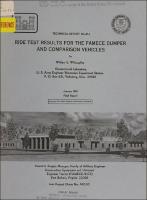Please use this identifier to cite or link to this item:
https://hdl.handle.net/11681/12675| Title: | Ride test results for the FAMECE dumper and comparison vehicles |
| Authors: | Project Manager. Family of Military Engineer Construction Equipment and Universal Engineer Tractor. Fort Belvoir (Va.) Willoughby, William E. |
| Keywords: | Dump trucks Vehicles Military Vehicles Construction equipment Loaders Ride dynamics Testing |
| Publisher: | Geotechnical Laboratory (U.S.) Engineer Research and Development Center (U.S.) |
| Series/Report no.: | Technical report (U.S. Army Engineer Waterways Experiment Station) ; GL-81-1. |
| Description: | Technical Report Abstract: Ride tests were conducted with the dumper version of The Family of Military Engineer Construction Equipment (FAMECE), the M51, 5-ton dump truck, and the John Deere (JD544A) front-end loader in two areas adjacent to the U.S. Army Engineer Waterways Experiment Station, Vicksburg, Mississippi. The purpose of the tests was to compare the ride quality of the vehicles at several measurement points in the cab and cargo areas (except front-end loader) and to determine the feasibility of using the FAMECE dumper or the M51, 5-ton dump truck, as a troop carrier around construction sites. The loader was included in the comparison testing because it is an unsprung vehicle, as is the FAMECE. The FAMECE dumper was tested in both the empty and loaded conditions, at tire pressures of 55 and 45 psi, and with the driver's seat under pressure (Bostrom suspension seat) and locked out of suspension (to determine effect of suspended seat on ride response at the driver's station). The M51, 5-ton dump ltruck, was tested in the empty and loaded configurations at 35-psi tire pressure while the John Deere 544A front-end loader was tested in only the empty condition at 50-psi tire pressure. Vertical ride response data were measured on the FAMECE and the M51 at the driver's station, the observer's station, and the left-center, right-center, and rear-center cargo areas. The JD544A loader data were measured at the driver 's station and at the rear hitch point of the loader . Ride response data at 6 w of absorbed power in the vertical direction (APvt) were obtained from plots of the field data for each test course. The terrain surface roughness corresponding to each test course was then used with the APvt values to develop characteristic ride performance curves for each measurement point on the test vehicles for each test condition. These curves were then compared to determine comparable ride performances of the vehicles. Results of the testing indicate that the ride performance at the driver 's station of the FAMECE was somewhat better without the driver's seat pressurized, and the best ride performance (of the conditions tested) was attained with the FAMECE loaded, tire pressure at 45 psi, and driver's seat not pressurized. The poorest ride of the five measurement points on the FAMECE at all loading configurations was obtained at the rear center of the cargo area. The ride performance as a troop carrier for the M51, 5-ton dump truck, at 35-psi tire pressure was slightly better than for the FAMECE at both 55- and 45 -psi tire pressures. The ride performance of the M51 at the driver's station was slightly better than for the other four measurement points on the vehicle. The ride performance at the driver's station for the test vehicles, empty, was best for the M51, 5-ton dump truck, followed by the FAMECE dumper and JD544A loader, which were about the same. |
| Rights: | Approved for public release; distribution is unlimited. |
| URI: | http://hdl.handle.net/11681/12675 |
| Appears in Collections: | Technical Report |
Files in This Item:
| File | Description | Size | Format | |
|---|---|---|---|---|
| TR-GL-81-1.pdf | 7.65 MB | Adobe PDF |  View/Open |